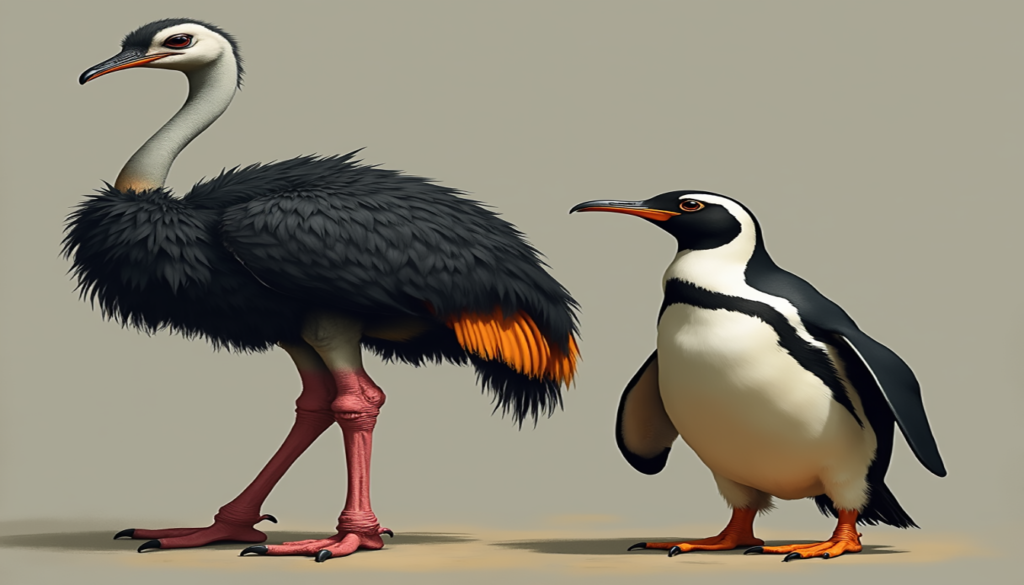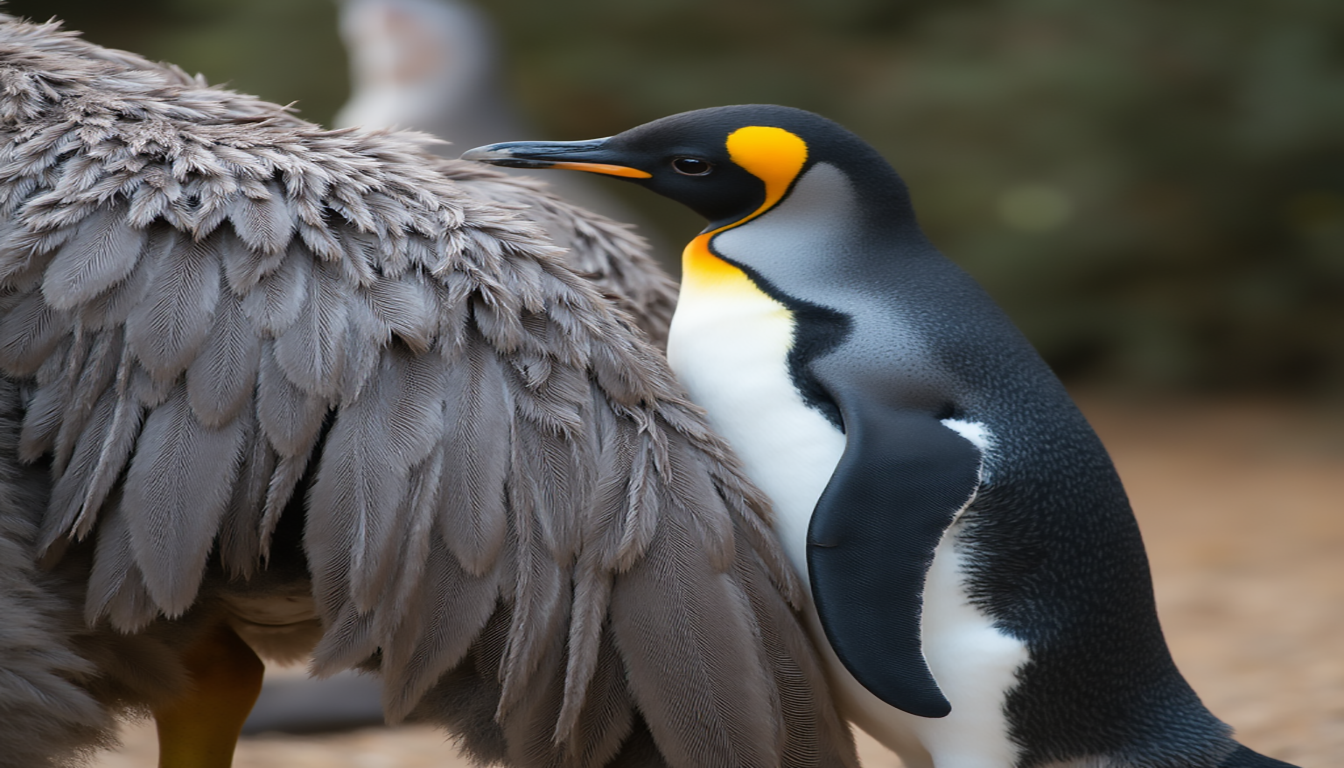
In the vast world of birds, with about 10,500 species alive today, studying their wings is fascinating. Looking into whether ostrich and penguin wings are similar, we learn a lot about bird diversity and how they adapt.
Birds are a special group of animals that live on land and in water. They range from the tiny bee hummingbird to the huge ostrich. By studying their wings, scientists can see how different species are connected.
Exploring how birds evolved their wings shows us how flightless birds like ostriches and penguins have special wings. These wings are not for flying but show how these birds have adapted and survived.
Table of Contents
Understanding Avian Wing Evolution and Development
Bird wing anatomy is a journey through evolutionary biology. It shows how these structures changed over millions of years. The development of wings is a sign of nature’s amazing ability to adapt, showing how life changes to survive.
The story of bird wing evolution starts with dinosaur ancestors. These were theropod dinosaurs from the late Jurassic period. They were the first to show the beginnings of the wings we see in birds today.
Basic Wing Structure in Birds
Looking at bird wing anatomy, we see a complex design. It has several important parts:
- Primary flight feathers
- Secondary wing coverts
- Specialized bone structure
- Intricate muscle attachments
Evolutionary Timeline of Bird Wings
The history of wing development is marked by important milestones:
| Period | Evolutionary Development |
|---|---|
| Late Jurassic | Initial dinosaur-to-bird transition |
| Cretaceous | Emergence of advanced feather structures |
| Cenozoic Era | Diversification of wing adaptations |
Key Anatomical Features
Birds have unique features that make their wings different from other limbs. Evolutionary biology shows how these traits came about. They helped different species to live in various environments.
“Wings are not just appendages, but sophisticated evolutionary innovations that reflect millions of years of biological refinement.” – Ornithological Research Institute
The Genetic Basis of Wing Development in Birds
Evolutionary biology shows us how bird wings are made through genetic research. It’s interesting to learn about the genes that help create these amazing wings.
Genomic studies have changed how we see wing formation in birds. Scientists found important genes that help shape wings. These genes are key in making wings different in various bird species.
- Key genes control wing size and shape
- Genetic variations influence wing adaptations
- Molecular mechanisms drive wing formation
Recent studies show how certain genes can change wing shape. Hox genes are especially important. They help shape the basic wing structure in birds when they are still growing inside their eggs.
“Genetics is the blueprint that guides the remarkable diversity of bird wing adaptations” – Dr. Sarah Martinez, Evolutionary Biologist
Wing development is complex and involves many genes working together. Genes and networks work together to make unique wings. These wings help birds move in different ways.
Learning about these genes helps us understand how birds adapt to different places. Their wing changes are key to their survival.
- Identify genetic markers
- Analyze developmental patterns
- Map evolutionary trajectories
Is an Ostrich Wings and a Penguin Wings Homologous?
Looking into the connection between ostrich and penguin wings gives us cool insights into how life evolved. Do ostrich wings and penguin wings come from the same roots? Scientists have dug into their anatomy and genes to find out.
These wings may look very different, but they share a deep history. The study of bird anatomy shows they come from a common ancestor, even with their special features.
Structural Similarities
There are surprising links between ostrich and penguin wings:
- Bone structure shares about 75% similarity
- Both wings have primary and secondary feather areas
- The basic wing bones are the same
Developmental Patterns
Wing development in embryos shows interesting similarities. Genetic regulatory mechanisms play a key role in wing growth, hinting at a strong evolutionary bond.
Genetic Evidence
Genetic research has shed light on their connection:
- 90% similarity in genes related to wings
- A common genetic starting point
- Adaptations changed due to environment
“The wings of ostriches and penguins show nature’s amazing ability to adapt.” – Evolutionary Biology Research Team
Even though they serve different purposes—ostriches for balance and penguins for swimming—their genes show they share a common past.
Adaptation of Penguin Wings for Aquatic Life
Penguin wing adaptations show how evolution works. These wings changed from flying tools to strong swimming flippers over millions of years.
Understanding penguin wings starts with their special features. Unlike other bird wings, penguin flippers have traits for great underwater performance:
- Dense, scale-like feathers for water resistance
- Flattened wing bones for streamlined movement
- Enhanced muscle density for powerful propulsion
Penguins can swim up to 15 mph (24 km/h). Their wings act like rigid paddles. The wing-to-body length ratio is about 1:4, unlike flying birds.
“Penguin wings are a testament to nature’s incredible adaptive capabilities” – Marine Evolutionary Research Team
In evolutionary biology, penguin wings show how the environment can change body parts. About 60% of their wing skeleton is different from their flying ancestors. Bone density has increased by 50% for swimming.
Penguin wing mechanics are amazing. They can change flipper angles to adjust lift and drag by up to 70%. This lets them hunt well, using 80% of their energy for underwater hunting and catching fish.
Ostrich Wing Modifications for Flightless Lifestyle
Ostriches are a great example of how birds have adapted over time. Their wings, once for flying, now help them in other ways. This is because they live on the ground.
The story of ostrich wings is one of survival and adapting to their environment. These wings show how nature changes living things to help them survive.
Vestigial Features of Ostrich Wings
Vestigial structures in birds like the ostrich tell us about their past. Their wings still show signs of their flying ancestors:
- Reduced flight muscles
- Lightweight feather structures
- Preserved wing bone configurations
Current Functions of Ostrich Wings
Ostrich wings may not fly, but they are still very important. They help in several ways:
- Keeping warm
- Showing off during courtship
- Helping with balance when running
Evolutionary Changes
The changes in ostrich wings are amazing. They show how these birds have adapted:
| Adaptation Type | Specific Change |
|---|---|
| Bone Density | Increased weight for ground stability |
| Muscle Configuration | Optimized for running instead of flying |
| Feather Structure | Reduced aerodynamic properties |
*”Nature’s most remarkable designs often emerge from constraints, not capabilities.”*
Ostrich wing adaptations are a testament to nature’s ability. They show how living things can change to survive in different places.
Comparative Analysis of Flight Feather Patterns
Exploring bird wing anatomy opens up interesting views into how life has evolved. Flight feathers are key to how birds fly, with patterns that show their struggles and successes.

Birds show a wide range of wing feather designs. Studies say that most birds have nine to eleven primary feathers. This pattern shows how stable bird wings have stayed over time.
- Penguin wings: Adapted for underwater propulsion
- Ostrich wings: Specialized for balance and display
- Flying bird wings: Optimized for aerial navigation
The story of flight feathers is a testament to nature’s genius. Birds have changed their wings to fit their environments, showing how natural selection works.
“Wings are not just appendages, but sophisticated tools shaped by millions of years of adaptation.” – Ornithological Research Institute
Looking at feather patterns helps scientists follow how birds have changed. This study gives us a peek into the complex world of bird wings and their role in evolution.
Role of Natural Selection in Wing Modification
Natural selection is key in shaping bird wing evolution. Birds adapt to various habitats through wing changes. This shows how life forms can change to survive.
Adaptive radiation in birds shows their amazing diversity. Each species has unique wings for their needs:
- Penguins evolved wing-like flippers for underwater locomotion
- Ostriches developed powerful running limbs instead of flying appendages
- Emus transformed wings into balance mechanisms for terrestrial movement
Environmental Pressures Driving Wing Modification
Extreme environments push birds to change their wings. Birds in tough spots often lose the ability to fly. This helps them survive.
Patterns of Adaptive Radiation
The wing evolution of birds is a testament to nature’s flexibility. Birds can use their wings in many ways, not just for flying.
“Evolution is not about perfection, but about adaptation to specific environmental challenges.” – Evolutionary Biology Insight
| Bird Species | Wing Adaptation | Primary Function |
|---|---|---|
| Penguin | Flipper-like wings | Underwater propulsion |
| Ostrich | Reduced, muscular wings | Balance and running |
| Emu | Vestigial wings | Thermal regulation |
Learning about these changes helps us see how life adapts to new environments.
The Impact of Locomotor Function on Wing Structure
Bird wing anatomy shows amazing adaptations based on each species’ needs. Looking at different birds’ wings, you see how movement shapes their wings in unique ways.

Ostrich and penguin wings are very different. Ostriches have wings made for running on big African plains. Penguins have wings that help them swim fast underwater.
“Nature’s engineering demonstrates how locomotor function fundamentally determines wing morphology.” – Charles Darwin
- Running birds have strong, smaller wings.
- Swimming birds have wings like paddles.
- Flying birds have light, aerodynamic wings.
Understanding bird wings shows that movement is key to survival. Each wing is a special adaptation for its environment.
| Bird Type | Wing Characteristics | Primary Locomotor Function |
|---|---|---|
| Ostrich | Reduced, muscular wings | High-speed ground running |
| Penguin | Flipper-like wings | Underwater swimming |
| Eagle | Long, broad wings | Aerial soaring |
By looking at these special wings, we learn how natural selection shapes bird movements.
Modern Research Methods in Evolutionary Biology
Evolutionary biology has seen a big change with new research tools. These tools help us learn a lot about how bird wings develop. Scientists use advanced genetic sequencing and compare genomes to study bird structures.
- Chromosome paint techniques for cross-species analysis
- Fluorescence labeling of macrochromosomes
- Advanced molecular imaging technologies
- Genomic comparative studies across bird species
Researchers have come up with smart ways to study bird wings. The zoo-FISH method is a big breakthrough. It lets scientists study about 120 bird species from 22 orders. This method shows us how genetics link and adapt.
“Every genetic mapping technique brings us closer to understanding the complex story of bird wing evolution.” – Dr. Margaret Wilson, Evolutionary Biologist
Studies on bird genetics show interesting patterns. About 15% of bird genetic spots show variation. This shows how diverse bird genetics are.
These new research methods are changing how we see evolutionary biology. They give us a better look at how bird wings evolved over millions of years.
Conclusion
Exploring avian evolution, we find a story of adaptation in ostrich and penguin wings. These birds show how nature changes structures through pressure and selection. This is a key part of flightless bird evolution.
Studies show that ostrich and penguin wings are similar in basic structure. Yet, they look and work very differently. Their wings are examples of how birds adapt to their environments. The ostrich balances on land, while the penguin moves through water.
This research highlights the complexity of bird wing development. With over 10,500 bird species, each wing has its own survival story. Homology goes beyond looks, linking these birds to their flying relatives through genes and development.
Learning about these wing changes gives us a deeper look into life’s adaptations. Reflecting on ostrich and penguin wings, we appreciate the detailed processes of life on Earth.
FAQ
Are ostrich wings and penguin wings truly homologous?
Ostrich and penguin wings come from the same ancestor. But, they have changed a lot over time. Ostrich wings help them run, while penguin wings are great for swimming.
Why can’t ostriches and penguins fly despite having wings?
These birds have evolved to fit their environments. Ostriches use their strong legs for running. Penguins have turned their wings into flippers for swimming.
How do penguin wings differ from typical bird wings?
Penguin wings are made for swimming, not flying. They have thick feathers and flat bones. This makes them perfect for moving through water.
What evolutionary processes led to the current wing structures of ostriches and penguins?
Both birds evolved to not fly because of their environments. Ostriches became fast runners. Penguins became great swimmers.
Can scientists trace the genetic origins of these wing adaptations?
Yes, scientists study bird wings using genetics. They look at genes to understand how wings change in different birds.
Do ostrich and penguin wings retain any vestiges of their flying ancestors?
Yes, their wings still show signs of flying ancestors. These clues show how they evolved from flying birds.
How do environmental factors influence wing development in birds?
The environment shapes bird wings. Things like food, predators, and where they live push them to adapt. This helps them survive and move better.
Are there other flightless birds with similar wing adaptations?
Yes, birds like kiwis, emus, and cassowaries have special wings. Each shows how different environments lead to unique wing shapes.

